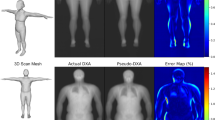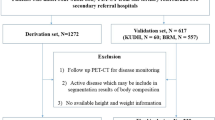Abstract
2D low-dose single-slice abdominal computed tomography (CT) slice enables direct measurements of body composition, which are critical to quantitatively characterizing health relationships on aging. However, longitudinal analysis of body composition changes using 2D abdominal slices is challenging due to positional variance between longitudinal slices acquired in different years. To reduce the positional variance, we extend the conditional generative models to our C-SliceGen that takes an arbitrary axial slice in the abdominal region as the condition and generates a defined vertebral level slice by estimating the structural changes in the latent space. Experiments on 1170 subjects from an in-house dataset and 50 subjects from BTCV MICCAI Challenge 2015 show that our model can generate high quality images in terms of realism and similarity. External experiments on 20 subjects from the Baltimore Longitudinal Study of Aging (BLSA) dataset that contains longitudinal single abdominal slices validate that our method can harmonize the slice positional variance in terms of muscle and visceral fat area. Our approach provides a promising direction of mapping slices from different vertebral levels to a target slice to reduce positional variance for single slice longitudinal analysis. The source code is available at: https://github.com/MASILab/C-SliceGen.
X. Yu and Q. Yang—Equal contribution.
Access this chapter
Tax calculation will be finalised at checkout
Purchases are for personal use only
Similar content being viewed by others
References
Almalioglu, Y., et al.: Endol2h: Deep super-resolution for capsule endoscopy. IEEE Trans. Med. Imaging 39(12), 4297–4309 (2020)
Andreoli, A., Garaci, F., Cafarelli, F.P., Guglielmi, G.: Body composition in clinical practice. Eur. J. Radiol. 85(8), 1461–1468 (2016)
Bezdek, J.C., Ehrlich, R., Full, W.: Fcm: the fuzzy c-means clustering algorithm. Comput. Ggeosci. 10(2–3), 191–203 (1984)
Cover, T.M.: Elements of information theory. John Wiley & Sons (1999)
De Bem, R., Ghosh, A., Boukhayma, A., Ajanthan, T., Siddharth, N., Torr, P.: A conditional deep generative model of people in natural images. In: 2019 IEEE Winter Conference on Applications of Computer Vision (WACV), pp. 1449–1458. IEEE (2019)
De Schutter, A., Lavie, C.J., Gonzalez, J., Milani, R.V.: Body composition in coronary heart disease: how does body mass index correlate with body fatness? Ochsner J. 11(3), 220–225 (2011)
Ferrucci, L.: The baltimore longitudinal study of aging (blsa): a 50-year-long journey and plans for the future (2008)
Florian, L.C., Adam, S.H.: Rethinking atrous convolution for semantic image segmentation. In: Conference on Computer Vision and Pattern Recognition (CVPR). IEEE/CVF (2017)
Gao, R., et al.: Lung cancer risk estimation with incomplete data: a joint missing imputation perspective. In: de Bruijne, M., et al. (eds.) MICCAI 2021. LNCS, vol. 12905, pp. 647–656. Springer, Cham (2021). https://doi.org/10.1007/978-3-030-87240-3_62
Gulrajani, I., Ahmed, F., Arjovsky, M., Dumoulin, V., Courville, A.C.: Improved training of wasserstein gans. Advances in neural information processing systems 30 (2017)
Henderson, P., Lampert, C.H., Bickel, B.: Unsupervised video prediction from a single frame by estimating 3d dynamic scene structure. arXiv preprint arXiv:2106.09051 (2021)
Hore, A., Ziou, D.: Image quality metrics: Psnr vs. ssim. In: 2010 20th International Conference on Pattern Recognition, pp. 2366–2369. IEEE (2010)
Kingma, D.P., Welling, M.: Auto-encoding variational bayes. arXiv preprint arXiv:1312.6114 (2013)
Kuriyan, R.: Body composition techniques. Indian J. Med. Res. 148(5), 648 (2018)
Landman, B., Xu, Z., Igelsias, J., Styner, M., Langerak, T., Klein, A.: Miccai multi-atlas labeling beyond the cranial vault-workshop and challenge. In: Proceedings of MICCAI Multi-Atlas Labeling Beyond Cranial Vault-Workshop Challenge, vol. 5, p. 12 (2015)
Larsen, A.B.L., Sønderby, S.K., Larochelle, H., Winther, O.: Autoencoding beyond pixels using a learned similarity metric. In: International Conference on Machine Learning, pp. 1558–1566. PMLR (2016)
Ledig, C., et al.: Photo-realistic single image super-resolution using a generative adversarial network. In: Proceedings of the IEEE Conference on Computer Vision and Pattern Recognition, pp. 4681–4690 (2017)
Mirza, M., Osindero, S.: Conditional generative adversarial nets. arXiv preprint arXiv:1411.1784 (2014)
Ribeiro, S.M., Kehayias, J.J.: Sarcopenia and the analysis of body composition. Adv. Nutr. 5(3), 260–267 (2014)
Ronneberger, O., Fischer, P., Brox, T.: U-Net: convolutional networks for biomedical image segmentation. In: Navab, N., Hornegger, J., Wells, W.M., Frangi, A.F. (eds.) MICCAI 2015. LNCS, vol. 9351, pp. 234–241. Springer, Cham (2015). https://doi.org/10.1007/978-3-319-24574-4_28
Sohn, K., Lee, H., Yan, X.: Learning structured output representation using deep conditional generative models. Advances in neural information processing systems 28 (2015)
Solanki, J.D., Makwana, A.H., Mehta, H.B., Gokhale, P.A., Shah, C.J.: Body composition in type 2 diabetes: change in quality and not just quantity that matters. Int. J. Preventive Med. 6 (2015)
Tang, Y., et al.: Body part regression with self-supervision. IEEE Trans. Med. Imaging 40(5), 1499–1507 (2021)
Tang, Y., et al.: Prediction of type II diabetes onset with computed tomography and electronic medical records. In: Syeda-Mahmood, T., Drechsler, K., Greenspan, H., Madabhushi, A., Karargyris, A., Linguraru, M.G., Oyarzun Laura, C., Shekhar, R., Wesarg, S., González Ballester, M.Á., Erdt, M. (eds.) CLIP/ML-CDS -2020. LNCS, vol. 12445, pp. 13–23. Springer, Cham (2020). https://doi.org/10.1007/978-3-030-60946-7_2
Tang, Y., et al.: Pancreas CT segmentation by predictive phenotyping. In: de Bruijne, M., Cattin, P.C., Cotin, S., Padoy, N., Speidel, S., Zheng, Y., Essert, C. (eds.) MICCAI 2021. LNCS, vol. 12901, pp. 25–35. Springer, Cham (2021). https://doi.org/10.1007/978-3-030-87193-2_3
Wang, Z., Bovik, A.C., Sheikh, H.R., Simoncelli, E.P.: Image quality assessment: from error visibility to structural similarity. IEEE Trans. Image Process. 13(4), 600–612 (2004)
Zhang, R., Isola, P., Efros, A.A., Shechtman, E., Wang, O.: The unreasonable effectiveness of deep features as a perceptual metric. In: CVPR (2018)
Acknowledgements
This research is supported by NSF CAREER 1452485, 2040462 and the National Institutes of Health (NIH) under award numbers R01EB017230, R01EB006136, R01NS09529, T32EB001628, 5UL1TR002243-04, 1R01MH121620-01, and T32GM007347; by ViSE/VICTR VR3029; and by the National Center for Research Resources, Grant UL1RR024975-01, and is now at the National Center for Advancing Translational Sciences, Grant 2UL1TR000445-06. This research was conducted with the support from the Intramural Research Program of the National Institute on Aging of the NIH. The content is solely the responsibility of the authors and does not necessarily represent the official views of the NIH. The identified datasets used for the analysis described were obtained from the Research Derivative (RD), database of clinical and related data. The inhouse imaging dataset(s) used for the analysis described were obtained from ImageVU, a research repository of medical imaging data and image-related metadata. ImageVU and RD are supported by the VICTR CTSA award (ULTR000445 from NCATS/NIH) and Vanderbilt University Medical Center institutional funding. ImageVU pilot work was also funded by PCORI (contract CDRN-1306-04869).
Author information
Authors and Affiliations
Corresponding author
Editor information
Editors and Affiliations
Rights and permissions
Copyright information
© 2022 The Author(s), under exclusive license to Springer Nature Switzerland AG
About this paper
Cite this paper
Yu, X. et al. (2022). Reducing Positional Variance in Cross-sectional Abdominal CT Slices with Deep Conditional Generative Models. In: Wang, L., Dou, Q., Fletcher, P.T., Speidel, S., Li, S. (eds) Medical Image Computing and Computer Assisted Intervention – MICCAI 2022. MICCAI 2022. Lecture Notes in Computer Science, vol 13437. Springer, Cham. https://doi.org/10.1007/978-3-031-16449-1_20
Download citation
DOI: https://doi.org/10.1007/978-3-031-16449-1_20
Published:
Publisher Name: Springer, Cham
Print ISBN: 978-3-031-16448-4
Online ISBN: 978-3-031-16449-1
eBook Packages: Computer ScienceComputer Science (R0)





